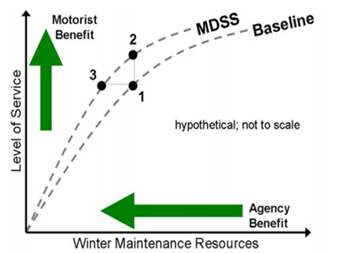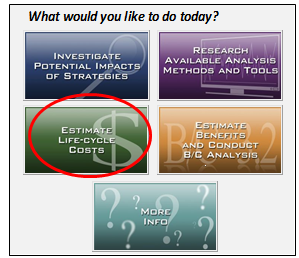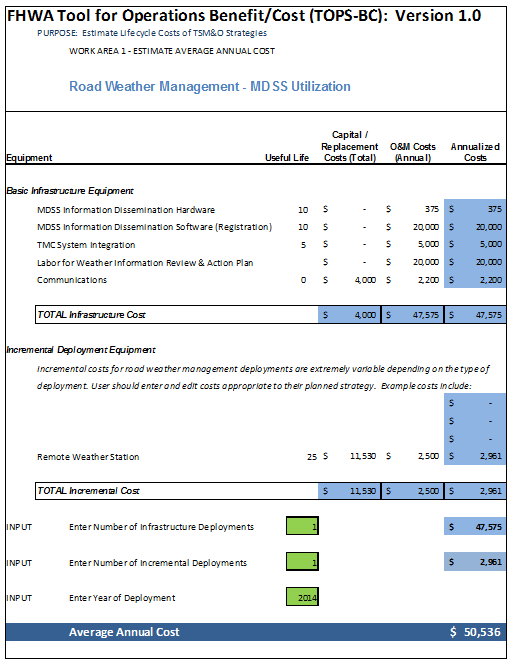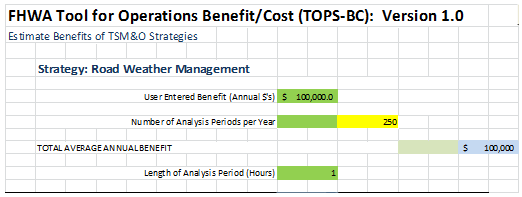Transportation Systems Management and Operations Benefit-Cost Analysis CompendiumCHAPTER 10. OTHER STRATEGIES
Note: Chapters 2, 3, and 4 of this Compendium contain a discussion of the fundamentals of benefit-cost analyses (BCA) and an introduction to BCA modeling tools. These sections also contain additional BCA references. Case Study 10.1 – Road Weather Pooled Fund Maintenance Decision Support System (MDSS) Implementation
Project Technology or StrategySixteen States have joined the Maintenance Decision Support System (MDSS) Pooled Fund Study led by the South Dakota DOT to develop an enhanced MDSS based on the Federal MDSS prototype. The MDSS integrates relevant road weather forecasts, coded maintenance rules of practice, and maintenance resource data to provide winter maintenance managers with recommended road treatment strategies. Coupled with other advanced technologies, MDSS has revolutionized DOT winter operations. MDSS is an integrated software application that provides users with real-time road treatment guidance for each maintenance route (e.g., treatment locations, types, times, and rates) to address the fundamental questions of what, how much, and when according to forecast road weather conditions, available resources, and local rules of practice. In addition, MDSS can be used as a training tool, as it features a “what if” scenario treatment selector that can be used to examine how the road condition might change over a 48-hour period with the user-defined treatment times, chemical types, or application rates. The essential functions of an MDSS may be visualized in three tiers: global, primary, and secondary. The global essential function of the MDSS is fulfilled as two interrelated applications: a “real-time assessment of current and future conditions” and “real-time maintenance recommendations.” Primary functions are those that have been created as part of the MDSS development process such as the road treatment module. A secondary function is one that is or can be accomplished by existing systems such as road weather management information systems (RWMIS) or road weather forecasts. Project Goals and ObjectivesThe purpose of this research project was to assess the benefits and costs associated with implementation of MDSS by State transportation agencies. In order to provide comparable benefits and costs within the analysis, South Dakota DOT carefully selected key MOEs to focus primarily on benefits to the implementing agency and ultimate users, including:
Detailed descriptions of the data collection and evaluation process are available in the full report referenced at the conclusion of this case. The costs and benefits associated with this technology are included in Table 50.
LOS = Level of service.
Note: Bold indicates included in methodology. Source: South Dakota DOT MethodologyA methodology consisting of a baseline data module and a simulation module was developed to analyze tangible benefits, which include the three selected benefits listed above. The methodology was applied to three Pooled Fund States: New Hampshire, Minnesota, and Colorado. The three States were chosen to provide case studies on the benefit-cost ratio of using MDSS. They were selected because they:
These criteria were selected so the results would be transferable to other Pooled Fund States. To evaluate the three cases, several years of historical weather, maintenance, and traffic use data were incorporated to establish baseline information for each route segment. Then, a simulation generated output from the MDSS for each of three scenarios: base case (point 1); same resources (Point 2), which means better level of service; and same conditions (Point 3), fewer resources, as shown in Figure 50. The simulation outputs from selected route segments were extrapolated to other route segments in each state to achieve a statewide BCA.  Source: North Dakota DOT Figure 50. Graph. Benefit-Cost Methodology and Relationship between Level of Service and Costs. The data from the three case studies was utilized to estimate a range of benefit and cost results for various conditions and situations. Compendium users can conduct similar analyses for their regions by using the process followed in this study and using their own State data. A complete citation for the study is available at the end of this case study. Model Run ResultsBCA results indicated that the use of MDSS could bring more benefits than costs. The case studies showed that the annual net benefit of using MDSS outweighed the cost to a significant degree, ranging from $488,000 to $2.68 million. The benefit cost findings are shown in Table 51. The benefit-cost ratios do not indicate conclusively which scenario produces better results. The case studies showed that there is a trade-off between agency benefits and user benefits. Increased use of material will achieve greater motorist benefits while increasing agency costs, and vice versa.
Source: South Dakota DOT
For the Same Condition scenario, the report notes that the contributions of user benefits to total benefits are almost the same as agency benefits for all cases. The split of benefits for the Same Resources scenario, however, have large variations. In the Minnesota case, the Same Resources scenario used much more salt (12.7 percent of total use) than the Base Case for winter maintenance and seemed to deviate more from the assumed “Same Resources” point 2 (in Figure 49) than the other two cases. Thus, Table 51 shows the negative impact on Agency Savings. The additional use of salt did improve motorist safety and mobility, but the total benefits were reduced. By comparing benefit-cost ratios, the Same Condition scenario tends to produce similar or better results than the Same Resources scenario. Overall, the study found MDSS offers State DOTs valuable guidance in their efforts to fine tune their maintenance decisions on winter operations, justifying their intent to continue future investments in MDSS. Key ObservationsThis case study presented a BCA of deploying MDSS for winter maintenance. A methodology that consisted of a baseline data module and a simulation module was developed and applied to three pooled fund States to analyze tangible benefits. Tangible costs were calculated based on winter maintenance information requested from the case study states. The three case studies collectively showed that the benefits of using MDSS outweighed associated costs. The benefit-cost ratios did not indicate which MDSS scenario was (always) better. However, it is most likely that an agency implementing MDSS would fall somewhere between the Same Resources scenario and the Same Condition scenario, seeking to achieve both a level of service improvement and a reduction in winter maintenance costs. The case studies also showed that there is a trade-off between agency benefits and user benefits. Increased use of material will achieve more motorist benefits while increasing agency costs, and vice versa. Case Study 10.2 – Hypothetical Maintenance Decision Support System (MDSS) Implementation
Note: Chapters 2, 3, and 4 of this Compendium contain a discussion of the fundamentals of benefit-cost analyses (BCA) and an introduction to BCA modeling tools. These sections also contain additional BCA references. Project Technology or StrategySeveral State DOTs and municipal public works departments have deployed Maintenance Decision Support Systems (MDSS) in urban settings. MDSS offers road maintenance managers guidance on efficient tactical deployment of road crews, equipment, and materials with the expectation that the MDSS can save State and local transportation agencies money and time while also enhancing the safety and mobility of the traveling public. Project Goals and ObjectivesThe purpose of this hypothetical BCA is to demonstrate how the TOPS-BC tool could support an RWM BCA evaluation where the user is supplying the required cost and benefit inputs. The example suggests that the user had estimated a clear set of benefits, along with real cost savings, that strongly justify the value—not only to State DOTs but also to local DOTs—of having an MDSS among the suite of tools and services they rely upon to support their road maintenance decisions. DataThis hypothetical evaluation was designed to be a “with-without MDSS” analysis intending to quantify the two benefit areas: those due to atmospheric and pavement forecasts and those resulting from treatment recommendations. Evaluation Hypothesis #1 – By using the MDSS forecasts as a tactical decision support tool, the State DOT will achieve reductions in shift hours or eliminate shift call-ins, thereby reducing labor hours and associated costs for winter maintenance. Over two winters combined, MDSS forecasts are assumed to be used for 56 events. Evaluation Hypothesis #2 – By using the MDSS updates and treatment recommendations, State DOTs will experience a reduction in the amount and cost of material used and a decrease in the number of truck miles, and hence cost of fuel and maintenance, over the course of an entire winter. The treatment assessment test was assumed to be conducted three times during one winter. It is assumed that only seven events occurred and most of them required primarily spot treatments and not extended material use.  Source: FHWA TOPS-BC Figure 51. Screenshot. Tool for Operations Benefit-Cost Analysis Navigation Column for Estimating Costs – Road Weather Management Strategies Benefits are realized primarily by reductions in labor hours due to the tactical decision support of deployment of road crews, equipment and materials offered by the MDSS. Costs will include one-time set-up costs and annual contract costs for the MDSS. Benefits and costs in this hypothetical scenario will be adjusted to constant 2009 dollars using inflation rates from the Bureau of Labor Statistics. Benefit-Cost AnalysisA BCA to determine whether to implement the MDSS for weather forecasting can be conducted using TOPS-BC. In this case, the user can utilize the TOPS-BC architecture to set up the BCA, to estimate annualized cost and benefits, to apply alternate discount rates, to estimate some benefits, and to display the results. Since TOPS-BC does not now provide cost and benefit data unique to a RWM MDSS application, the user must supply much of this data. The information can be collected from other DOTs that have implemented MDSS programs for weather forecasting, or the data can be produced from vendor estimates. A search of the FHWA ITS database may provide much of this information. To set up TOPS-BC to conduct this analysis, the user will open the spreadsheet modeling tool to the start page (Figure 51) and click on “Estimate Life-Cycle Costs.” In the left-hand column of the Cost Page (Figure 52), click on “Road Weather Management.” Depending on the current version of TOPS-BC, you may or may not see any information on the costs of MDSS systems. If no MDSS costs are displayed, the user can input cost data from available information on the specific project or locate cost information on the FHWA ITS Cost database. (http://www.itscosts.its.dot.gov/its/benecost.nsf/ByLink/CostDocs).  Source: FHWA TOPS-BC Figure 52. Screenshot. Tool for Operations Benefit-Cost Analysis Start Page – Estimate Life-Cycle Costs Function If the user needs to input new cost information, TOPS-BC maintains a blank cost estimation worksheet that can be used to create cost estimation capabilities for new strategies that may not currently be included. A blank cost estimation worksheet is provided as a hidden sheet titled COST TEMPLATE, or the user can edit the cost line items on the Road Weather Cost sheet. In this case, we have edited the existing RWM cost sheet to reflect the cost assumptions. These are hypothetical costs only to demonstrate how TOPS-BC works. It is suggested that you download the latest version of the TOPS-BC model and follow along with this discussion. These procedures are explained in the TOPS-BC Users Manual, which is available at: https://ops.fhwa.dot.gov/publications/fhwahop13041/fhwahop13041.pdf. If we take the cost estimates for a statewide deployment of AVL to support the maintenance vehicle fleet as shown in Figure 52, the user can create a cost sheet in TOPS-BC. TOPS-BC will take the basic cost information provided and generate the annual costs as well as the net present value of cost for use in a BCA. The user also provides a start date, an analysis period, and a discount rate. In this example, we are running TOPS-BC and we would like to modify the inputs to reflect new data. We might do this because of the similarity of this particular deployment to another deployment where data has been collected on the actual costs or benefits experienced. With the MDSS option, we know that certain benefits will be realized as we tested (assumed) the historic application in our community and measured the changes in agency staff costs for overtime. We also investigated the change in materials application, but at this time we could not definitively identify materials savings. By using the navigation column on the far left, (Figure 54) we can go to the Road Weather Management benefit inputs page and input new information specific to MDSS. These values will be used in all calculations calling for these values in TOPS-BC. The user can also test the inputs to see where additional benefits may be realized. This can be accomplished by modifying assumptions about the project costs, size or other dimension. The user can get a range of estimated benefits and costs. One can also test the value assumptions. For example, an alternative set of data on materials savings from application of MDSS forecasts could reflect a cost savings that would improve the applicability of this tool for any project. Go to the “Benefits” section of Road Weather Management spreadsheet and move to the very bottom of the page to the cell labeled “User Entered Benefit (Annual $s)” and enter the calculated benefit amount, in this case, $100,000. (Remember that FHWA is always adding material to TOPS-BC, so check to see if the model contains benefit data assumptions that might be helpful.) TOPS-BC will now use the $100,000 entry in all of its BCA calculations.  Source: FHWA TOPS-BC Figure 53. Screenshot. Tool for Operations Benefit-Cost Analysis Cost Table Edited for Maintenance Decision Support System Cost Inputs.  Source: FHWA TOPS-BC Figure 54. Screenshot. Bottom of Road Weather Management Benefit Spreadsheet Model Run ResultsNow go back to the far left Navigation Column (Figure 54) and select, “My Deployments.” In the middle of the sheet you will see the results as shown in Table 52.
In this case, TOPS-BC estimates that the project benefits exceed the costs. This results from the gain in operating efficiency (labor savings) for the system under study. This is a hypothetical case, but it is loosely based on an actual MDSS deployment and evaluation so that we could provide a demonstration of how TOPS-BC can be used as the BCA tool to support RWM decisions.
Source: FHWA TOPS-BC
Key ObservationsAlthough not directly assessed in this BCA, the benefits at the agency level that have been observed in this hypothetical example flow down to the traveling public in terms of the agency’s ability to maintain the level of service on the roadways and thereby make them safer for travelers. Finally, although this model is just a prototype, it provides a framework for the development of a model which could be used to measure the effectiveness in costs savings and expected safety (as measured by crash reductions) of a roadway, thereby providing an agency with objective and predictable measures for determining whether an MDSS deployment is necessary. Prior to and after the deployment, the State DOT should collect data on system performance to be able to compare the changes brought about by the deployment. Those performance changes reveal impacts on both freeway and MDSS performance. These realized changes are what a pre-project deployment analysis needs in order to estimate the expected project benefits and costs. Once the project is deployed, performance indicators and their changes are known and can be used as an estimate of what might be expected if a similar project is deployments. | |||||||||||||||||||||||||||||||||||||||||||||||||||||||||||||||||||||||||||||||||||||||||||||||||||||||||||||||||||||||||||||||||||||||||
|
United States Department of Transportation - Federal Highway Administration |
||